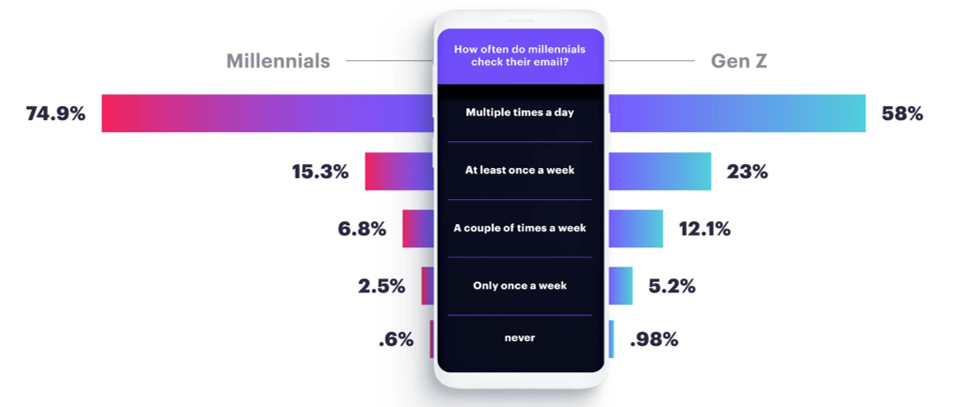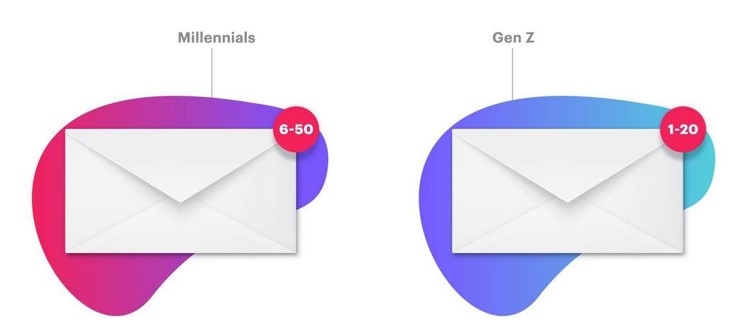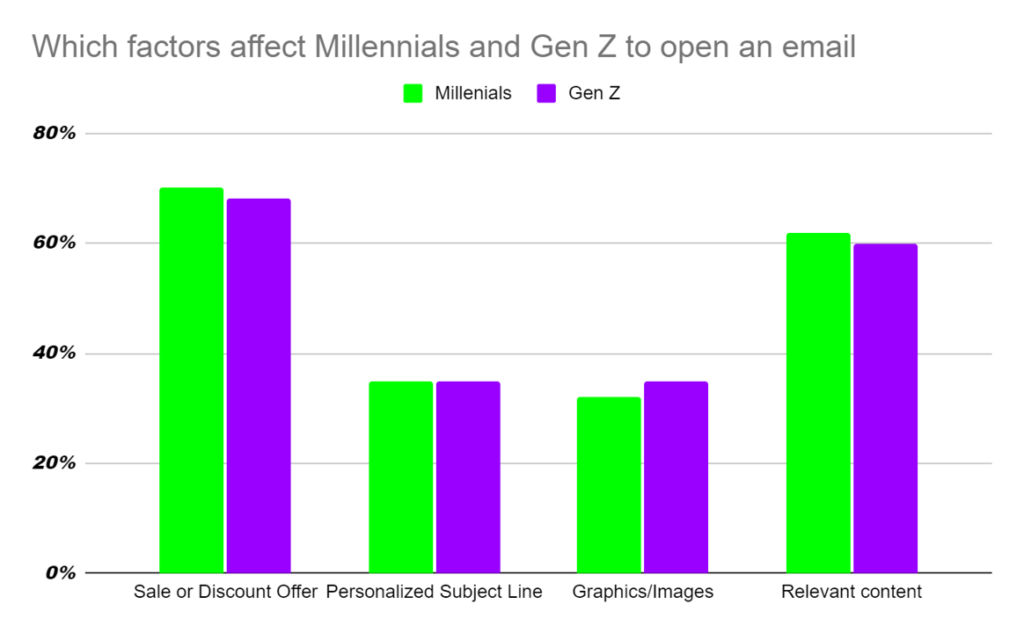- Home
- Friday Column
- Email Marketing for Millennial ...

Millennials are the first generation that experienced the transition from analog to digital communication and set the stage for how brands interact with consumers today. On the other hand, Generation Z, fully immersed in the digital world from their earliest years, managed to bring new aspects to this interaction.
Both generations, while closely linked in their digital savviness and preferences for engaging with brands, exhibit distinct characteristics and behaviors that set them apart. Marketing to Millennials involves understanding their unique position as digital transitioners. Gen Zs introduce new dynamics—embodied in things only Gen Z will understand—that demand a fresh marketing perspective.
This article provides a comprehensive outlook on the preferences of both generations when it comes to brand interactions via email and gives marketing recommendations for turning them into loyal customers.
Email usage: How often do Gen Z and Millennials use email and why?

The dynamics of email engagement are evolving, and that’s a proven fact! To provide high-quality marketing to different generations, it is crucial to be able to answer questions about their habits and preferences.
So, does Gen Z use email? Absolutely, and here’s an outlook on their habits compared to Millennials.
58% of Gen Z’s scan their emails multiple times a day, and another 23% check in at least once a week. Millennials, deeply embedded in the workforce, frequently check their emails—a majority do so multiple times a day. A smaller segment, about 15.3%, prefers a weekly dive into their inbox.
This pattern reveals a significant insight: both Millennials and Gen Z are far from abandoning email, engaging with it regularly. What’s in it for marketers? It’s a clear path forward to understanding the habits of both generations and tailoring strategies to provide effective marketing to Gen Z and Millennials.
A study from Edison Mail provides a detailed overview of purposes for checking emails both by Millennials and Gen Z’s—and they are quite diverse! So, what do both generations try to find in their inboxes when they open their emails?
Online shopping: A significant 67% of Millennials use email mainly for online shopping, underscoring the importance of Millennial marketing. 60% of Gen Z also prioritize email for shopping, indicating a shared interest in browsing and purchasing products online.
Work correspondence: For both generations, email serves as a crucial channel for work-related communication, with 58% of Millennials and 53% of Gen Z engaging in work correspondence via email.
Identity verification: Surprisingly, identity verification for online accounts ranks third for both groups, showcasing the integral role of email in maintaining online security and access to various digital platforms.
Customer service and business communication: Nearly half of Millennials (50%) use email to interact with customer service and business representatives. In comparison, 36% of Gen Z representatives utilize email for similar purposes, which is slightly less but still significant for investing in Gen Z marketing focused on customer service.
Newsletters and financial/banking information management: Both generations show lesser interest in using email for newsletters and managing banking information. While email is less preferred for these purposes, there might still be opportunities for marketers to engage audiences with highly relevant and personalized content in these areas.
Email volume: How many emails do Gen Z and Millennials receive daily, and what do they think about it?

Millennials in the U.S. show an impressive openness to daily promotional emails, with 43% welcoming them into their inboxes. This contrasts with Gen Z, where only 35% appreciate daily email blasts. Besides, both generations would rather unsubscribe than be overwhelmed.
It is worth mentioning that Millennials tend to navigate a busier digital environment, with the majority receiving between 6 to 50 emails daily. This creates a competitive atmosphere for marketers, urging the need for creativity in subject lines and truly engaging content to cut through the noise.
On the other hand, Gen Z’s inboxes are less crowded, with most getting 1 to 20 emails a day, offering a clearer path for marketers to make an impact with more meaningful Gen Z advertising.
In other words, while with Millennials the challenge lies in standing out in a crowded space, with Gen Z the focus should be on the significance of each message.
Optimal email frequency: How often to send emails to maximize engagement without causing fatigue?
When it comes to numbers, over 30% of Gen Zers express a preference for receiving brand emails multiple times a week, and almost the same number is open to daily updates. The majority, at 31.8%, favor hearing from brands a couple of times a week, indicating a balanced appetite for engagement.
Talking about email frequency, both demographics exhibit a low tolerance for feeling spammed. Thus, 70% of Millennials express frustration over irrelevant or redundant content, underscoring the need for tailored and meaningful communication.
For marketers, these insights into marketing to Gen Z and advertising to Millennials offer clear guidance: it’s not so much about the frequency of emails but the quality and relevance of the content.
Influencing factors for opening emails: Effect of subject lines, sender reputation, and personalization.

Both demographics show a strong inclination towards emails that feature sales or discounts, with 70.2% of Millennials and a closely aligned percentage of Gen Z expressing this preference. The importance of relevant content, personalized subject lines, and visually appealing graphics is also emphasized across both groups, illustrating the core elements of effective email engagement.
Specifically, 35.1% of Gen Z highlight the subject line as a critical factor in their decision to open an email.
Another aspect that will increase your chances for an email to be open—and that is fair for both Millennials and Gen Z’s—is incorporating social proof, such as reviews and testimonials, into emails. Mentioning CSR and sustainability sits particularly well, especially with Millennials.
Besides, both generations’ preference for mobile accessibility of content (67% for Gen Z and 59% for Millennials) emphasizes the importance of responsive design that adapts to different screen sizes.
Preferred email content: What each generation likes and hates getting in their inbox.
An impressive 82.3% of Gen Zers favor receiving promotions and special discounts via email. They also demonstrate a preference for personalized product suggestions, updates from companies, and links to blogs and other informative content. Newsletters, too, hold value for Gen Zs, but only in case they provide concise, compelling, or uniquely informative material.
Besides, the data point out that more than half of Gen Z and over a third of Millennials like getting brand emails. This goes in alignment with the findings of the University of South Carolina, which tried to find out how to market to Millennials.
The research points out that the top three categories on which millennials prefer spending money are: socialization, education, and apparel.

That explains why Millennials value:
- promotional offers and discounts,
- informative newsletters,
- loyalty programs and rewards,
- educational content and how-tos.
Email pet peeves: Complaints or dislikes about emails that can lead to unsubscribing or negative perceptions.
And what about email turn-offs? Well, all the content that is not engaging, not relevant, too long or too pushy, lacks visual and interactive design, and feels inauthentic has a very high chance of ending up in an email Trash folder. That stands true for both Millennials and Gen Zs.
Besides, research from Retail Touch Points reveals that Millennials find it annoying to get sales reminders from brands about items left in the cart, previously browsed items, or, for example, interest-based products.
How Gen Z and Millennials like to engage with brands via email and other digital platforms.
When it comes to brand engagement, email stands as the ultimate leader for both Millennials and Generation Z. An impressive 62% of Millennials and an even more striking 65% of Generation Z report that email is their preferred method of brand communication. These impressive numbers by far outshine all other channels.
But what gives email its ultimate appeal among all other channels? The answer is personalization. It makes email the preferred channel for the brand, especially when reaching the younger generations who value authenticity and personal touch in brand interactions. So, if you are evaluating strategies for best email marketing to Gen Z vs. Millennials, personalization will definitely please them both.
Preferred communication channels: Through which channels do Millennials and Gen Z prefer to engage with brands?
Millennials are the generation that embraces the blend of traditional and online communication channels. 64% favor email as their primary mode of brand communication. Besides email, Millennials are also very much at home with social media, with 47% of them ranking it as their second-choice communication platform.
Beyond these two, Millennials are also inclined towards messaging platforms, seeing them as a quick and effective way to communicate without the need to make phone calls. Brands crafting Millennial marketing should consider leveraging a mix of channels, including web-based chat services, email, Facebook, and WhatsApp.
Generation Z: Email, surprisingly, remains relevant even for this generation. However, the digital savviness of this generation goes beyond only this channel. Gen Z expects brands to meet them on mobile apps and through engaging visual content on platforms like Snapchat, TikTok, YouTube, and Instagram. Furthermore, Gen Z values authenticity, favoring genuine interactions over traditional marketing pitches and often turning to influencers for product insights and recommendations.

Expectations from email marketing: What each generation wants from email marketing.
- Captivating subject lines. Given that Millennials receive up to 50 emails daily and Gen Z spends extensive time on social media, subject lines must grab attention immediately. So, a must-click subject line is crucial to grab attention in a crowded and highly competitive email space.
- Values and beliefs. Both generations seek more than just transactional relations with brands. Millennials and Gen Zs want to engage with brands that echo their values. Highlighting your brand’s commitment to causes like sustainability can resonate deeply, with 92% of Millennials more inclined to support ethical brands.
- Customer loyalty programs. Loyalty programs are a key driver of repeat business, with 76% of Millennials and 43% of Gen Z stating that such programs encourage more frequent purchases. Tailored offers sent by email can enhance loyalty and spending from both generations.
- Valuable content and content experimentation. Content is everything, and for younger audiences who are fast at filtering irrelevant information, each email must offer value. Overly promotional content is a turn-off, so focus on relevance and engagement. Another tip: try new formats. Interactive emails and multimedia like GIFs, infographics, and videos can significantly increase engagement from both Millennials and Gen Z alike.
Effective email marketing strategies
Millennials and Gen Z are two young generational groups that stand closest to each other, so it’s no surprise that they share some views and preferences for email content. This overlap can provide marketers with insights into marketing to different generations.
So, which strategies work universally well both as marketing to Gen Z and Millennials?
- Personalization: Utilize data analytics to personalize emails based on user behavior, preferences, and purchase history. Both generations value feeling recognized and understood by brands, making personalized content a universal win.
- Mobile optimization: Given the high mobile usage rates among both groups, ensure emails are responsive and visually appealing on all devices. With 59% of Millennials and 67% of Gen Z checking emails on their phones, mobile-friendly design is non-negotiable.
- Value-driven promotions: Discounts, exclusive offers, and early access promotions cater to both groups’ desire for valuable deals. Highlighting these offers can significantly increase open rates and conversions.
- Engaging visual content: Incorporate eye-catching visuals, GIFs, and videos to grab attention. Rich media content is more likely to engage and retain the interest of these visually oriented audiences.
- Social proof and user-generated content: Share reviews, testimonials, and user-generated content to build trust and authenticity. Both Millennials and Gen Z trust peer opinions and real-world experiences.
Nonetheless, both Millennials and Gen Zs have their particularities that should not be missed when trying to maximize the success of your marketing emails.
So, Millennial marketing should pay attention to:
- Educational content: Millennials value growth and learning opportunities, so provide how-tos, guides, and educational material related to your product or industry.
- Loyalty programs: Millennials, having more purchasing power, appreciate being rewarded for their brand loyalty and are likely to engage more with brands that recognize their value.
- Emails focused on social impact: Millennials look to support brands that reflect their values and contribute positively to the world. So, share your brand’s efforts in sustainability, charity, or social causes.
What about things only Gen Z will understand?
- Short, snappy content: Gen Z’s attention spans are shorter, so keep emails concise, direct, and easily digestible.
- Interactive elements: To engage Gen Z’s desire for dynamic and participatory content, use interactive email elements like polls, quizzes, or swipeable galleries.
- Trends: Gen Z is highly connected to the digital landscape and appreciates when brands are culturally relevant and up-to-date. So tap into current trends, memes, and pop culture references for effective Gen Z marketing.
To Sum Up
As we tried to showcase in this article, the strategies for engaging Millennials and Gen Z are diverse, yet at the core, they are built on personalization, value-driven content, and mobile optimization. Nonetheless, despite recognizing shared digital savviness and preferences for engaging content, marketing to Gen Z still differs from marketing to Millennials.
A blend of universal principles of contemporary email marketing with the knowledge about generational differences can provide marketers with a perfect formula for the creation of marketing emails that make a true difference for brands, regardless of whose inbox they land in.



